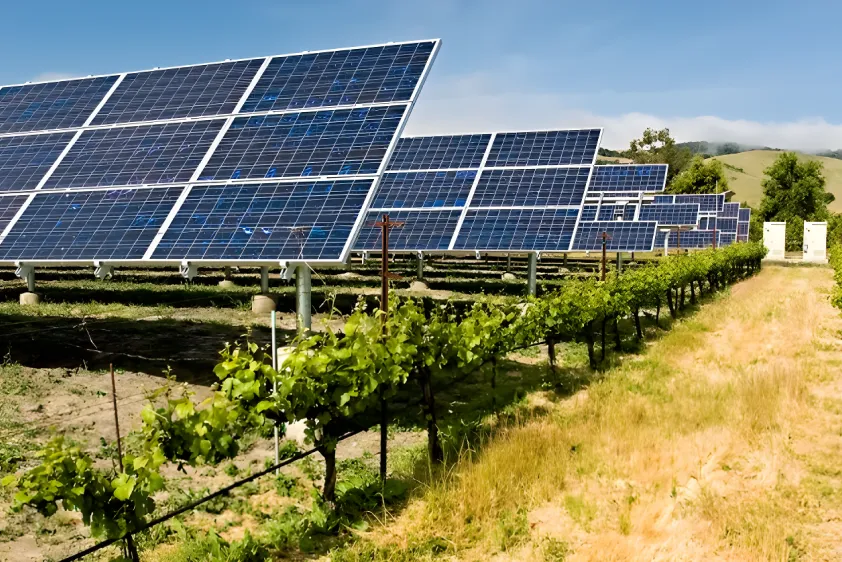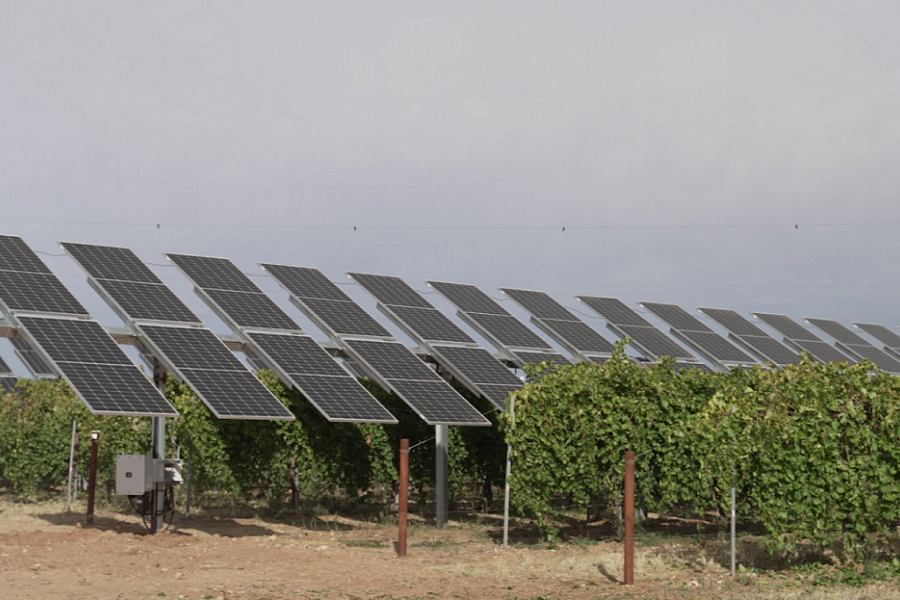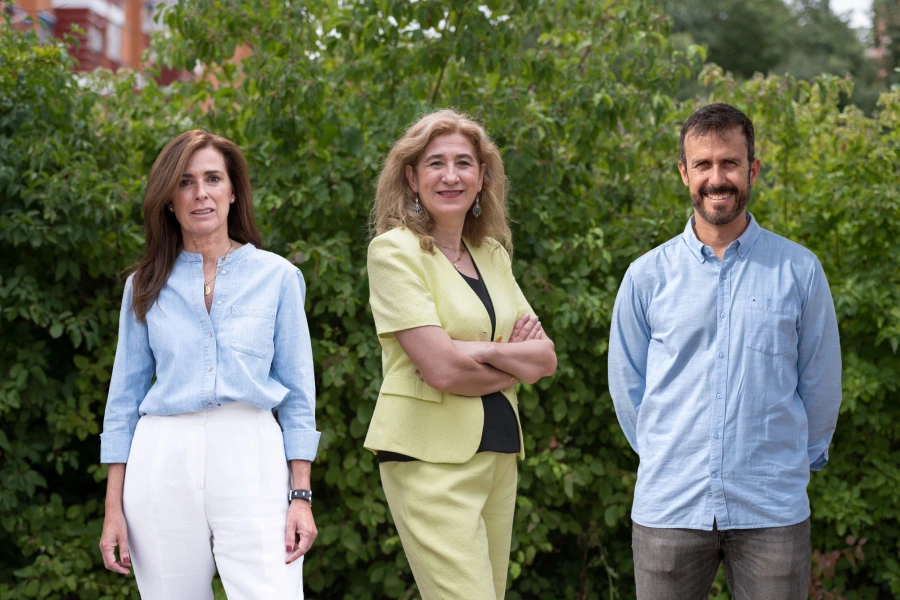AGROVOLTAIC ENERGY IN SPAIN
Agrovoltaic, when photovoltaics and agriculture drive sustainable development in Spain

Agrovoltaics, a benchmark in the transition to a more sustainable agriculture.
Agrovoltaics maximises land yields by smartly integrating solar panels into agricultural or livestock environments. By combining technology and sustainable agriculture, agrovoltaics contributes to food security and climate change mitigation.
What is agrovoltaic energy?
Agrovoltaics involves using the same area of land to obtain both solar energy and agricultural products. This technique was originally conceived by Adolf Goetzberger and Armin Zastrow in 1981, but the concept did not become popular until the last decade, with studies conducted by Christophe Dupraz. These studies concluded that agrovoltaic systems increase overall land productivity by 35-73%.
Agrovoltaics encourages solar panels to coexist with crops and livestock on the same surface. Although on days when the sun is not shining, the lack of solar exposure can affect the productivity of plantations, energy production compensates for this loss. According to a study published in 2019 by the prestigious scientific journal Nature, if just 1% of arable land were dedicated to producing solar energy, it would be possible tooffset the world's energy demand.
The use of solar energy in agricultural areas also encourages photovoltaic self-consumption, since farms' energy needs can easily be met with the electricity generated. Moreover, this model of sustainable agricultural activity (agrovoltaics) has close links with "smart farming": the installation of photovoltaic panels on land used for agriculture or livestock farming. In this way, a two-in-one approach is achieved, i.e. encouraging agriculture and livestock farming while generating electricity from a single place.
How does agrovoltaic energy work in Spain?
Spain leads in the production of solar energy in Europe. Thanks to its number of installations and hours of sunshine, this energy has become one of the country's sustainability benchmarks. In fact, according to official data from Red Eléctrica Española, solar photovoltaic capacity has tripled in recent years.
When implementing agrovoltaic energy, structures or cables that are typically used are approximately five metres above the crop field. This elevation allows farm machinery access to the crops below. These panels can also be installed on the rooftop of greenhouses. Another solution is dynamic agrovoltaics, which involves installing the panels on elevated cables – a lighter alternative easy to disassemble and allowing for manual adjustments to be made over the seasons and as the farmer works on different areas of the land. In addition, in the case of mushrooms, free spaces between panels are used for planting.
Some installations have monitoring systems, which allow the panels to be orientated in an optimal way, preventing them from constant casting shade in the same place; thus adapting to the specific needs of the plants. These systems require advanced software models that take crop growth phases and weather conditions into account. In the future, solar panels will be developed using semi-transparent polymers, allowing the wavelengths needed for photosynthesis to pass through and absorb the rest to generate energy.
Benefits of agrovoltaics in Spain
- Reduction of greenhouse gas emissions in the agricultural sector.
- Relief of pressure on ecosystems and biodiversity. The photovoltaic plants are a pesticide-free zone that no one can enter; so they are biodiversity-friendly.
-
Increase of the economic value of agrovoltaic farms by more than 30% as it improves land-use efficiency and yields, according to some economic studies. In addition, agrovoltaics encourage the increase of their efficiency by up to 186%, according to data from the Fraunhofer Institute.
-
Self-consumption and reduction of energy dependence. The installation of solar panels in the cropareas allows the electricity generated on site to be used for the operation of these plantations.
-
Natural clearing, thanks to the animals, which avoids the use of machinery and chemical products. In addition, the livestock benefit from natural grass and its quality.
-
The shade from the solar panels is beneficial for crops that require cooler and more humid environments.
-
Promotion of solar grazing, which aims to provide an area of the park for local livestock farmers to graze their herds.
Agrovoltaic energy applications in Spain
The applications of agrovoltaic energy vary depending on the environment and the specific use of the installations. Below, we share some of its uses to better understand its possibilities and usefulness.
-
Electricity production and crops. Solar panels share the same land as fruit, vegetables and cereals, which they protect from atmospheric phenomena.
-
Electricity generation and grazing. On non-arable land, or where the climate is less suitable, the ground beneath the solar panels can be used for livestock grazing.
-
Electricity production, fresh water and crops in coastal areas. The electricity generated is used to power a desalination plant that produces water for the crops and for human consumption.
The evolution of agrovoltaic energy
In recent years, Spain has experienced a remarkable evolution in the field of photovoltaic energy. From traditional solar energy to innovative agrovoltaics, the sector has undergone changes that have redefined its impact on the country's energy matrix.
While the first wave of developments focused on conventional solar photovoltaic energy (with the implementation of technologies such as solar panels on large parks and rooftops), over time, the efficiency of conventional solar plants has been improved – optimising their collection. In addition, the integration of advanced storage systems has addressed the challenge of solar energy intermittency, ensuring a constant supply in variable climate situations.
With the evolution to agrovoltaics, this symbiosis of agricultural production and clean energy production has been successful in increasing land use efficiency and reducing greenhouse gas emissions.
Iberdrola España Success Stories
In recent years, Iberdrola España has carried out over 1,450 actions to protect biodiversity. Our commitment to the use of renewables and the preservation of ecosystems is reflected in the initiatives we have carried out to ensure the combination of renewable projects and biodiversity conservation.
Thus, in 2022 we collected the world's first organic solar honey at the Campo Arañuelo photovoltaic plant. Furthermore, in March 2021 we installed 162 hives at the Andévalo photovoltaic plant (Huelva), with the aim of protecting a species such as bees and making progress in the decarbonisation of the economy.
It is also worth mentioning one of Iberdrola España’s most emblematic success story in the agrovoltaic sector: Winesolar. This project – promoted in the vineyards of González Byass and Grupo Emperador, located in the town of Guadamur in Toledo – has set up the first smart agrovoltaic plant in Spain. The production of this agrovoltaic plant, with a capacity of 40 kW, is entirely used for the self-consumption bythe González Byass and Grupo Emperador wineries. They are thus able to reduce their emissions, make progress in the decarbonisation of their activity and reduce their energy costs. This installation allows the layout of the modules to be adapted to the needs of the vineyards, in order to regulate the incidence of the sun and the temperature through the shade of the panels.
Our will to ensure the coexistence of renewable energies and fauna and flora involves awards. With the aim of recognising the best practices of coexistence between renewable projects and their environment, in March 2023 we launched the first edition of the "Convive Awards". This initiative aims at giving visibility to initiatives, alliances, companies, actions or local entities that exemplify the integration of renewable energies with socio-economic development and the conservation of biodiversity in Spain.


Discover Energía que cambia vidas
Related information





